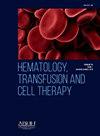EVALUATION OF 18F-PSMA PET/CT UPTAKE IN PATIENTS WITH GASTRIC ADENOCARCINOMA: AN EXPLORATORY ANALYSIS
IF 1.8
Q3 HEMATOLOGY
引用次数: 0
Abstract
Introduction/Justification
Gastric cancer is the fifth most common cancer and the third leading cause of cancer-related death worldwide. The diagnosis of gastric tumors involves a multimodal approach, including upper gastrointestinal endoscopy with biopsy, computed tomography (CT), and endoscopic ultrasound. Positron emission tomography combined with computed tomography scanners (PET/CT) is widely used in cancer diagnosis and staging as it reflects the tumor's molecular activity. However, its indication in gastric cancer is limited, being reserved for specific clinical scenarios. In this context, evaluating new imaging methods for gastric tumors becomes crucial. In recent years, PET/CT targeting PSMA (Prostate-Specific Membrane Antigen) has been explored beyond prostate cancer. PSMA expression in the endothelium of newly formed vasculature (neoangiogenesis) has already been described in other cancer types, such as colorectal, gastric, and pancreatic; however, its role in gastric cancer evaluation remains poorly understood.
Objectives
This study aims to investigate 18F-PSMA PET/CT uptake in different clinical scenarios of patients with gastric cancer and compare it with 18F-FDG PET/CT uptake (glucose metabolism).
Materials and Methods
This study was approved by the Institutional Review Board (CAAE 76237023.0.0000.5404). It was conducted in patients diagnosed with gastric adenocarcinoma treated at the Clinic Hospital of Unicamp (HC-UNICAMP) who underwent both Fludeoxyglucose F-18 (FDG) and prostate-specific membrane antigen (PSMA) positron emission tomography/computed tomography (PET/CT) to evaluate radiotracer uptake in the primary lesion and metastases.
Results
A total of 24 patients with a confirmed diagnosis of gastric adenocarcinoma through upper gastrointestinal endoscopy and biopsy underwent 18F-PSMA PET/CT and 18F-FDG PET/CT. Among them, 5 had metastatic disease, and 19 had localized tumors. Among the 5 metastatic patients, 3 demonstrated PSMA uptake, of whom 2 had undergone chemotherapy before imaging, while 1 had not received chemotherapy prior to imaging. Among the 19 patients with localized tumors, 5 showed PSMA uptake, all of whom had not received neoadjuvant therapy. The remaining 14 patients showed no PSMA uptake, with 2 having undergone neoadjuvant therapy before the scan. Among these 14 patients without PSMA uptake, 6 also showed no FDG uptake, and only 1 had previously undergone neoadjuvant therapy.
Conclusion
Our results demonstrated that PSMA uptake in gastric cancer is heterogeneous. It is well known that gastric cancer has high molecular, histological, and phenotypic heterogeneity, making its classification and treatment challenging. Accordingly, the findings of this descriptive analysis suggest that PET-PSMA uptake in gastric cancer may be associated with tumor biology, as well as the molecular profile of the tumor and its metastases, supporting the hypothesis that tumor heterogeneity contributes to the uptake or lack thereof of the radiotracer. Differential gene expression analysis may provide valuable insights into tumor heterogeneity and help identify potential biomarkers for patient stratification and the development of novel therapeutic approaches.
评估胃腺癌患者的18f-psma pet / ct摄取:一项探索性分析
胃癌是世界上第五大最常见的癌症,也是导致癌症相关死亡的第三大原因。胃肿瘤的诊断涉及多模式方法,包括上消化道内镜活检,计算机断层扫描(CT)和内镜超声。正电子发射断层扫描与计算机断层扫描(PET/CT)相结合,因其能反映肿瘤的分子活性而广泛应用于肿瘤的诊断和分期。然而,它在胃癌中的适应症是有限的,为特定的临床情况保留。在这种背景下,评估新的胃肿瘤成像方法变得至关重要。近年来,PET/CT靶向PSMA(前列腺特异性膜抗原)的研究已超越前列腺癌的范畴。PSMA在新形成的血管内皮(新生血管生成)中的表达已经在其他类型的癌症中被描述,如结肠直肠癌、胃癌和胰腺癌;然而,其在胃癌评估中的作用仍然知之甚少。目的探讨不同临床情况下胃癌患者18F-PSMA PET/CT摄取情况,并与18F-FDG PET/CT摄取(葡萄糖代谢)进行比较。材料和方法本研究经机构审查委员会批准(CAAE 76237023.0.000 .5404)。该研究在Unicamp临床医院(HC-UNICAMP)诊断为胃腺癌的患者中进行,这些患者接受了氟氧葡萄糖F-18 (FDG)和前列腺特异性膜抗原(PSMA)正电子发射断层扫描/计算机断层扫描(PET/CT),以评估放射示踪剂在原发病变和转移灶中的摄取情况。结果24例经上消化道内镜和活检确诊为胃腺癌的患者分别行18F-PSMA PET/CT和18F-FDG PET/CT检查。其中转移性肿瘤5例,局限性肿瘤19例。在5例转移性患者中,3例表现出PSMA摄取,其中2例在成像前接受化疗,1例在成像前未接受化疗。19例局部肿瘤患者中,5例出现PSMA摄取,均未接受新辅助治疗。其余14例患者未显示PSMA摄取,其中2例在扫描前接受了新辅助治疗。在这14例没有PSMA摄取的患者中,6例也没有FDG摄取,只有1例以前接受过新辅助治疗。结论胃癌组织对PSMA的摄取具有异质性。众所周知,胃癌具有高度的分子、组织学和表型异质性,使其分类和治疗具有挑战性。因此,这项描述性分析的结果表明,胃癌中PET-PSMA的摄取可能与肿瘤生物学、肿瘤的分子特征及其转移有关,这支持了肿瘤异质性导致放射性示踪剂摄取或缺乏的假设。差异基因表达分析可以为肿瘤异质性提供有价值的见解,并有助于识别潜在的生物标志物,用于患者分层和开发新的治疗方法。
本文章由计算机程序翻译,如有差异,请以英文原文为准。
求助全文
约1分钟内获得全文
求助全文
来源期刊

Hematology, Transfusion and Cell Therapy
Multiple-
CiteScore
2.40
自引率
4.80%
发文量
1419
审稿时长
30 weeks
 求助内容:
求助内容: 应助结果提醒方式:
应助结果提醒方式:


